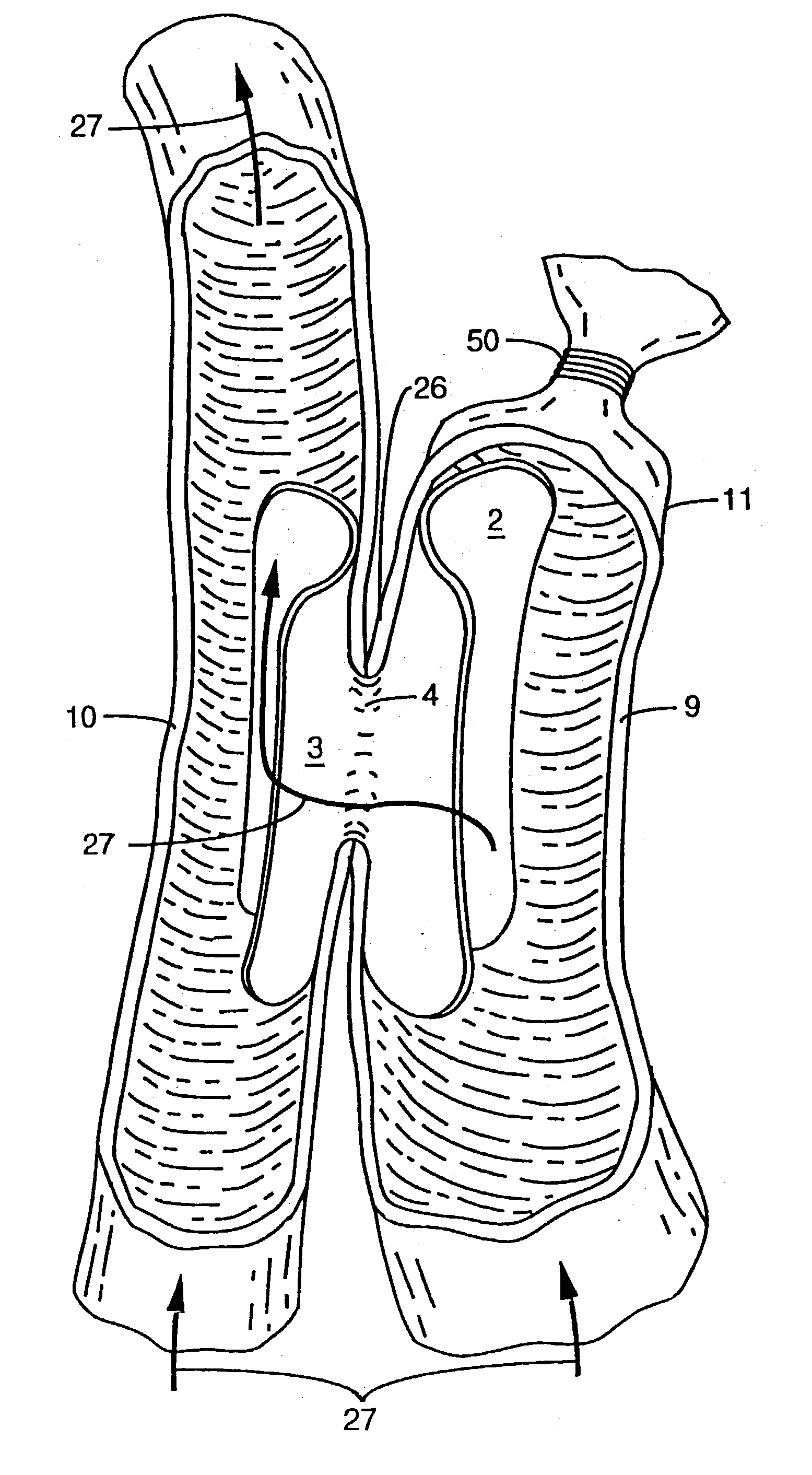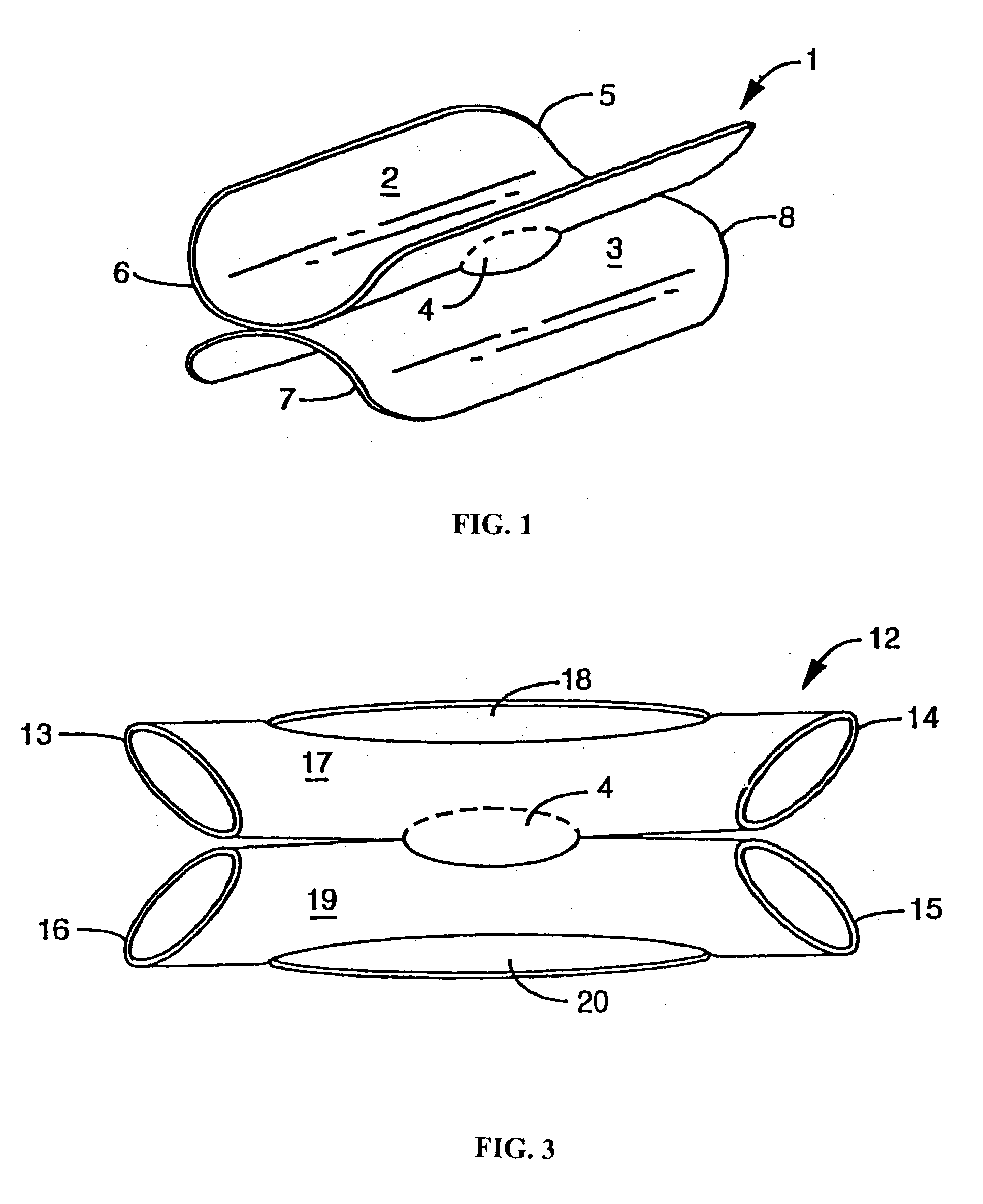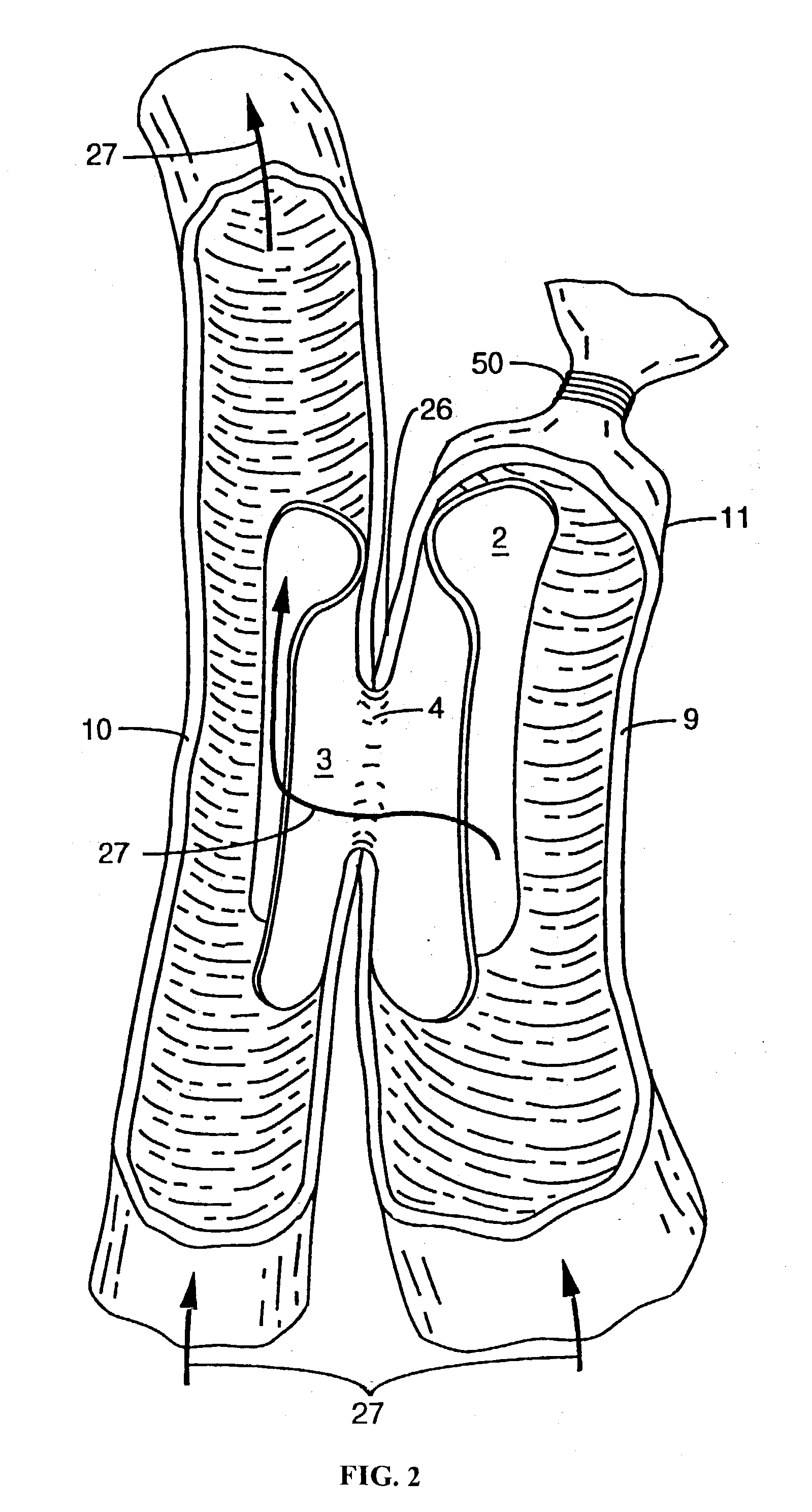Surgeons must delicately sew the vessels together being careful not to suture too tightly so as to tear the delicate tissue, thereby injuring the vessel which may then result in poor patency of the
anastomosis.
Recently, some surgeons have used staples and associated stapling mechanisms and techniques to form an
anastomosis, but many of the same difficulties and problems have presented themselves.
Basically, the tension and / or compression forces exerted on the vessel walls as a result of suturing and stapling can result in damage to the vessel wall, even to the extent of causing
tissue necrosis.
Damage to the intima of a vessel is particularly problematic as it may inhibit the natural
bonding process that occurs between the anastomized vessels and which is necessary for sufficient patency.
Futhermore, damaged vessel walls are likely to have protuberances that when exposed to the bloodstream could obstruct
blood flow or may produce turbulence which can lead to formation of
thrombus,
stenosis and possible
occlusion of the
artery.
The procedures are made more difficult due to the multiple characteristics that are unique to each
anastomosis and to each patient.
For example, the arteries' internal
diameter dimensions are difficult to predict and the inside walls are often covered with deposits of stenotic plaque which creates the risk of dislodging plaque into the patient's
blood stream during the anastomosis procedure.
The resulting emboli in turn create a greater risk of
stroke for the patient.
The vessel walls can also be friable and easy to tear, and are often covered with
layers of fat and / or are deeply seated in the myocardium, adding to the difficulty of effectively and safely performing conventional anastomotic procedures.
Cardiac surgeons sometimes inadvertently suture too loosely, resulting in leakage of fluid from the anastomosis.
In addition to creating a surgical field in which it is difficult to see, leakage of fluid from the anastomosis can cause serious drops in
blood pressure, acute or chronic.
The loss of blood may cause other deleterious effects on the patient's
hemodynamics that may even endanger the patient's life.
In addition,
blood loss may induce local
scar tissue to develop which often results in further blockage within or damage to the sewn vessel.
Furthermore, anastomosing blood vessels may involve risks of physical injury to the patient.
When done on a
beating heart, this manipulation may result in hemodynamic compromise possibly subjecting the patient to cardiac arrest, particularly during lengthy procedures.
In "stopped heart" procedures, patients are supported by
cardiopulmonary bypass and, thus, risk post-surgical complications (e.g.,
stroke) that vary directly with the duration for which the heart is under cardioplegic arrest.
Consequently, surgeons are constantly searching for techniques to both reduce the risk of
tissue damage as well as the laborious and time-consuming task of vessel suturing.
While stapling is successful in gastrointestinal procedures due to the
large size and durability of the vessels, as briefly mentioned above, it is less adequate for use in
vascular anastomosis.
The manufacturing of stapling instruments small enough to be useful for anastomosing smaller vessels, such as
coronary arteries, is very difficult and expensive.
As stapling instruments are typically made of at least some rigid and fixed components, a stapler of one size will not necessarily work with multiple sizes of vessels.
This may significantly raise the cost of the equipment and ultimately the cost of the procedure.
When staples are adapted to conform to the smaller sized vessels, they are difficult to maneuver and require a great deal of time, precision, and fine movement to successfully approximate the vessel tissue.
Everting may not always be practical especially for smaller arteries because of the likelihood of tearing when everted.
Another factor which may lead to damage or laceration of the vessel and / or leakage at the anastomosis site is the variability of the force that a surgeon may use to fire a stapling instrument causing the possible over-or under-stapling of a vessel.
Rectifying a poorly
stapled anastomosis is itself a complicated, time-consuming process which can further damage a vessel.
This procedure is difficult to perform and
time consuming, the difficulty compounded by the small sizes of the vessels involved.
Furthermore, anastomosing the
vein and
artery together using sutures suffers from many of the problems described above with respect to suturing, such as suturing too loosely, suturing too tightly, inducing
scar tissue, damaging the vessel, and the like.
However, devices and methods currently used to close openings in vessels have not been wholly satisfactory.
First, the pressure application technique may fail to prevent hemorrhage.
Such a hemorrhage may be a life-threatening hemorrhage or lead to a large
hematoma.
A large
hematoma in the
groin, for instance, may compromise the major nerve supply to the anterior lower extremity.
Additionally, the digital
compression method is time-consuming, frequently requiring one-half hour or more of compression before
hemostasis is assured, and is very uncomfortable for the patient and frequently requires administering analgesics to be tolerable.
Thus, the increased length of in-
hospital stay necessitated by the pressure application technique considerably increases the expense of procedures requiring such
vascular access.
The incidence of these complications increases when the sheath size is increased and when the patient is anticoagulated.
It is clear that the
standard technique for arterial closure can be risky and is expensive and onerous to the patient.
While potentially effective, this approach suffers from a number of problems.
It can be difficult to properly locate the interface of the overlying tissue and the adventitial surface of the
blood vessel, and locating the
fastener too far from that surface can result in failure to provide
hemostasis and subsequent
hematoma and / or pseudo aneurism formation.
Other possible complications include infection as well as adverse reactions to the collagen
implant.
However, these devices involve complex componentry and require much precision on the part of the user in order to achieve an acceptable vessel closure.
However, the device described in the '461 patent suffers from significant disadvantages.
For example, if the thread element is secured too tightly to the
skin, excess tension may be created on the vessel which may result in blood leakage from the opening and damage to the vessel wall.
Such vessel wall damage may result in
ischemia and / or thrombus forming at the site which can dislodge and potentially be life-threatening.
On the other hand, if the thread element is secured too loosely to the
skin, the flexible member may not be held in proper alignment over the opening, thereby enabling blood to leak from the opening.
Still further, if the wall of the vessel is compressed too tightly between the flexible member and the ring, the vessel wall may be damaged resulting in
ischemia and the like.
 Login to View More
Login to View More  Login to View More
Login to View More 


